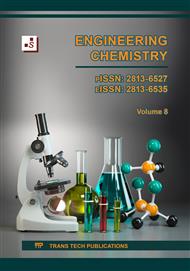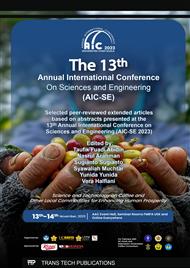[1]
I. Khan, K. Saeed, I. Zekker, B. Zhang, A.H. Hendi, A. Ahmad, S. Ahmad, N. Zada, H. Ahmad, L.A. Shah, T. Shah, and I. Khan, Review on Methylene Blue: Its Properties, Uses, Toxicity and Photodegradation, Water (Switzerland). 14 (2022).
DOI: 10.3390/w14020242
Google Scholar
[2]
L. Dwi Rha Hayu, E. Nasra, M. Azhar, S. Benti Etika, and A. Tawar Barat, Adsorption of Methylene Blue Dyes Using Activated Carbon from Durian Peel (Durio zibethinus Murr.), Chem. J. 10 (2021).
DOI: 10.24036/p.v11i1.113349
Google Scholar
[3]
U. Dwijayanti, G. Gunawan, D. Setyo Widodo, A. Haris, L. Suyati, and R. Ariadi Lusiana, Adsorption Of Methylene Blue (Mb) Using Coal Fly Ash Activated By Naoh Solution, Anal. Environ. Chem. 5 (2020).
DOI: 10.23960/aec.v5.i1.2020.p01-14
Google Scholar
[4]
M. Maryudi, S. Amelia, and S. Salamah, Removal of Methylene Blue of Textile Industry Waste with Activated Carbon using Adsorption Method, Reactor. 19 (2019).
DOI: 10.14710/reaktor.19.4.168-171
Google Scholar
[5]
E. Misran, O. Bani, E.M. Situmeang, and A.S. Purba, Removal efficiency of methylene blue using activated carbon from waste banana stem: Study on pH influence, IOP Conf. Ser. Earth Environ. Sci. 122 (2018).
DOI: 10.1088/1755-1315/122/1/012085
Google Scholar
[6]
Mariana, F. Mulana, F.M. Djuned, M. Fadli, and M. Meilian, Fabrication of Activated Charcoal from Coconut Shell Combined with Coal Fly Ash from PLTU Nagan Raya for Adsorption of Methylene Blue, IOP Conf. Ser. Mater. Sci. Eng. 796 (2020).
DOI: 10.1088/1757-899x/796/1/012049
Google Scholar
[7]
Mariana, F. Mulana, D.N. Pratama, and S. Muchtar, Adsorption of ammonia and methylene blue using combination of cost-effective coconut husk activated carbon and silica (Sio2) as an adsorbent, Rasayan J. Chem. 13 (2020).
DOI: 10.31788/rjc.2020.1346006
Google Scholar
[8]
T. Mukhtar, H.P. Widayat, and Y. Abubakar, Analysis of the Quality of Patchouli Oil and Factors that Influence Farmers' Decisions in Choosing a Distilling Kettle, J. Teknol. Dan Ind. Pertan. Indones. 12 (2020).
Google Scholar
[9]
R. Idrus, B.P. Lapanporo, and Y.S. Putra, Effect of Activation Temperature on the Quality of Activated Carbon Made from Coconut Shell, Prism. Fis. 1 (2013).
Google Scholar
[10]
L.H. Rahayu, S. Purnavita, and H.Y. Sriyana, Potential of Coconut Fiber and Shell as an Adsorbent to regenerate Used Cooking Oil, Momentum. 10 (2014).
Google Scholar
[11]
A. Sartape, A. Mandhare, P. Salvi, D. Pawar, P. Raut, M. Anuse, and S. Kolekar, Removal of Bi (III) with adsorption technique using coconut shell activated carbon, Chinese J. Chem. Eng. 20 (2012).
DOI: 10.1016/s1004-9541(11)60247-4
Google Scholar
[12]
M. Mariana, M. Mahidin, F. Mulana, T. Agam, and F. Hafdiansyah, Reactivity improvement of Ca(OH)2 sorbent using diatomaceous earth (DE) from Aceh Province, IOP Conf. Ser. Mater. Sci. Eng. 345 (2018).
DOI: 10.1088/1757-899x/345/1/012001
Google Scholar
[13]
A.N. Ebelegi, E.I. Toneth, and M.A. Bokizibe, Determination of Physiochemical Properties of Biosorbents Synthesized from Water Melon Rind Using Microwave Assisted Irradiation Procedure, Open J. Phys. Chem. 12 (2022).
DOI: 10.4236/ojpc.2022.122002
Google Scholar
[14]
A. Mengistu, M. Abewaa, E. Adino, E. Gizachew, and J. Abdu, The application of Rumex abyssinicus based activated carbon for Brilliant Blue Reactive dye adsorption from aqueous solution , BMC Chem. 17 (2023).
DOI: 10.1186/s13065-023-01004-2
Google Scholar
[15]
Y. Sarasati, I. Thohari, and B. Sunarko, Differences in the thickness of coffee grounds activated charcoal filters in reducing iron (Fe) levels in clean water, J. Penelit. Kesehat. Suara Forikes. 9(2018).
Google Scholar
[16]
S. Oko, Mustafa, A. Kurniawan, and E.S.B. Palulun, Effect of Temperature and HCl Activator Concentration on the Characteristics of Activated Carbon from Coffee Grounds, Metana: Media Komun. Rekayasa Proses Dan Teknol. Tepat Guna. 17 (2021).
Google Scholar
[17]
I. Sailah, F. Mulyaningsih, A. Ismayana, T. Puspaningrum, A.A. Adnan, and N.S. Indrasti, Performance Of Activated Carbon From Cassava Peel In Reducing Phosphate Concentration In Laundry Liquid Waste, J. Teknol. Ind. Pertan. 30 (2020).
Google Scholar
[18]
S. Huda, R.D. Ratnani, and L. Kurniasari, Test of Active Carbon Characteristics from Boiler Charcoal Waste Using Wood Type and Carbonization Temperature Variables , Inov. Tek. Kim. 5 (2017).
Google Scholar
[19]
Y. Ambarwati, N.P. Syarifah, and L.U. Widodo, Utilization of cassava stem waste as activated charcoal and the effect of HCL activator and activation time on the quality of activated charcoal, J. Ind. Eng. Manag. 14 (2019).
DOI: 10.33005/tekmapro.v14i2.122
Google Scholar
[20]
R. Dewi, A. Azhari, and I. Nofriadi, Carbon Activation of Areca Nut Shell Using Chemical Activator Koh, J. Teknol. Kim. Unimal. 9(2021).
Google Scholar
[21]
S. Maulina, G. Handika, Irvan, and A.H. Iswanto, Quality comparison of activated carbon produced from oil palm fronds by chemical activation using sodium carbonate versus sodium chloride , J. Korean Wood Sci. Technol. 48 (2020).
DOI: 10.5658/wood.2020.48.4.503
Google Scholar
[22]
L.E. Laos and A. Selan, Utilization of Cassava Peel as Raw Material for Active Carbon, J. Teknol. Kim. Unimal. 4(2017).
Google Scholar
[23]
N.K. Kalagatur, K. Karthick, J.A. Allen, O.S.N. Ghosh, S. Chandranayaka, V.K. Gupta, K. Krishna, and V. Mudili, Application of activated carbon derived from seed shells of Jatropha curcas for decontamination of zearalenone mycotoxin, Front. Pharmacol. 8 (2017).
DOI: 10.3389/fphar.2017.00760
Google Scholar
[24]
F. Hysna, M. Mariana, F. Mulana, M. Mahidin, and S. Muchtar, Physically activated patchouli dregs carbon as a biosorbent for remotion of methylene blue , Mater. Today Proc. 87 (2023).
DOI: 10.1016/j.matpr.2023.02.399
Google Scholar
[25]
A. Salah Omer, G.A. El Naeem, A.I. Abd-Elhamid, O.O.M. Farahat, A.A. El-Bardan, H.M.A. Soliman, and A.A. Nayl, Adsorption of crystal violet and methylene blue dyes using a cellulose-based adsorbent from sugercane bagasse: characterization, kinetic and isotherm studies, J. Mater. Res. Technol. 19 (2022).
DOI: 10.1016/j.jmrt.2022.06.045
Google Scholar
[26]
V.A. Mentari and S. Maulina, Comparison of Functional Groups and Surface Morphology of Activated Carbon from Oil Palm Fronds Using Phosphoric Acid (H3PO4) and Nitric Acid (HNO3) Activators , Talent. Conf. Ser. Sci. Technol. 1 (2018).
DOI: 10.1088/1757-899x/505/1/012023
Google Scholar
[27]
D.H. Astuti, A. Kurnia, N. Fadilla, D.H. Astuti, A. Kurnia, N. Fadilla, Y.I. Mahendra, P. Studi, T. Kimia, F. Teknik,R. Rungkut, and M. Gunung, Quality Study of Adsorbent Composition Made from Raw Materials Quality Study of Adsorbent Composition With Sidoarjo, J. Tek. Kim. 14 (2020).
DOI: 10.33005/jurnal_tekkim.v14i2.2033
Google Scholar
[28]
D.I.P. Kusumaningrum, D.H.A. Sudarni, and S. Wahyuningsih, Optimization of the Effect of Contact Time and Adsorbent Dosage of Eucalyptus Leaf Waste (Melaleuca cajuputi) using the Langmuir Adsorption Isotherm Method Optimization of the Effect of Contact Time and Adsorbent Dosage of Eucalyptus (Melaleuca cajuputi) , J. Tek. Kim. USU. 11 (2022).
DOI: 10.32734/jtk.v11i2.9119
Google Scholar
[29]
J.M. Jabar, M.A. Adebayo, I.A. Owokotomo, Y.A. Odusote, and M. Yılmaz, Synthesis of high surface area mesoporous ZnCl2–activated cocoa (Theobroma cacao L) leaves biochar derived via pyrolysis for crystal violet dye removal, Heliyon. 8(2022).
DOI: 10.1016/j.heliyon.2022.e10873
Google Scholar



